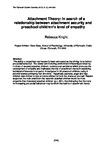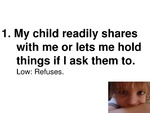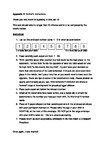Attachment Theory: In search of a relationship between attachment security and preschool children's level of empathy
| dc.contributor.author | Knight, R. | |
| dc.date.accessioned | 2019-05-14T14:12:21Z | |
| dc.date.available | 2019-05-14T14:12:21Z | |
| dc.date.issued | 2011 | |
| dc.identifier.citation |
Knight, R. (2011) Attachment Theory: In search of a relationship between attachment security and preschool children's level of empathy, The Plymouth Student Scientist, 4(1), p. 240-258. | en_US |
| dc.identifier.issn | 1754-2383 | |
| dc.identifier.uri | http://hdl.handle.net/10026.1/13933 | |
| dc.description.abstract |
The ability to empathise has frequently been advocated as the driving force behind pro-social behaviour. The tender and nurturing environment inherently provided by mothers of securely attached children, constructs an ambience which promotes the development of empathy and implicates the role of attachment theory in explaining individual differences in empathy. Investigated in 58 preschool children, using 8 pictorial scenes portraying four emotions – happiness, sadness, anger and fear, children were invited to rate emotions elicited for both the character and self. Results supported the main prediction that securely attached children would be more empathic than insecurely attached children (p < .001), thus indicating that the route for increasing pro-social behaviour may lie within the realms of attachment theory. | en_US |
| dc.language.iso | en | en_US |
| dc.publisher | University of Plymouth | |
| dc.rights | Attribution 3.0 United States | * |
| dc.rights.uri | http://creativecommons.org/licenses/by/3.0/us/ | * |
| dc.subject | pro-social behaviour | en_US |
| dc.subject | empathy | en_US |
| dc.subject | attachment theory | en_US |
| dc.subject | pre-school | en_US |
| dc.subject | children | en_US |
| dc.subject | relationship | en_US |
| dc.title | Attachment Theory: In search of a relationship between attachment security and preschool children's level of empathy | en_US |
| dc.type | Article | |
| plymouth.issue | 1 | |
| plymouth.volume | 4 | |
| plymouth.journal | The Plymouth Student Scientist |





